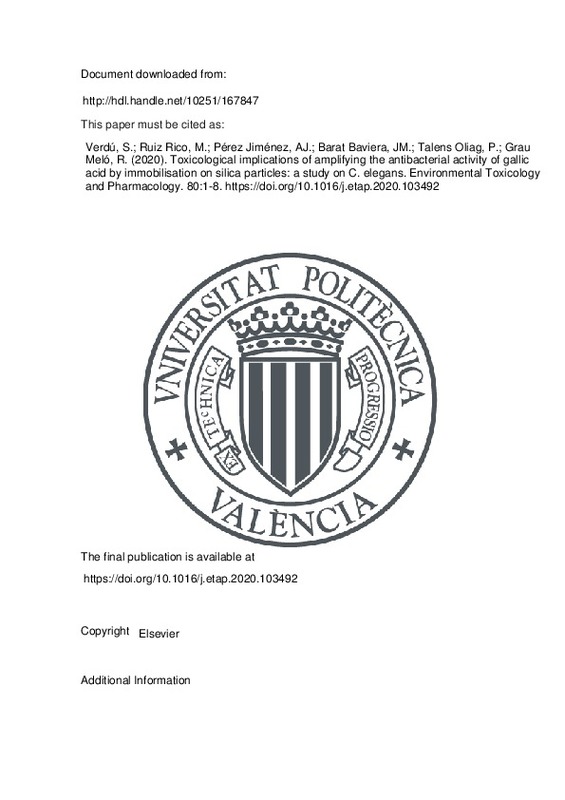Abdel-Wahhab, M. A., Aljawish, A., Kenawy, A. M., El-Nekeety, A. A., Hamed, H. S., & Abdel-Aziem, S. H. (2016). Grafting of gallic acid onto chitosan nano particles enhances antioxidant activities in vitro and protects against ochratoxin A toxicity in catfish ( Clarias gariepinus ). Environmental Toxicology and Pharmacology, 41, 279-288. doi:10.1016/j.etap.2015.12.005
Borges, A., Saavedra, M. J., & Simões, M. (2012). The activity of ferulic and gallic acids in biofilm prevention and control of pathogenic bacteria. Biofouling, 28(7), 755-767. doi:10.1080/08927014.2012.706751
Borges, A., Ferreira, C., Saavedra, M. J., & Simões, M. (2013). Antibacterial Activity and Mode of Action of Ferulic and Gallic Acids Against Pathogenic Bacteria. Microbial Drug Resistance, 19(4), 256-265. doi:10.1089/mdr.2012.0244
[+]
Abdel-Wahhab, M. A., Aljawish, A., Kenawy, A. M., El-Nekeety, A. A., Hamed, H. S., & Abdel-Aziem, S. H. (2016). Grafting of gallic acid onto chitosan nano particles enhances antioxidant activities in vitro and protects against ochratoxin A toxicity in catfish ( Clarias gariepinus ). Environmental Toxicology and Pharmacology, 41, 279-288. doi:10.1016/j.etap.2015.12.005
Borges, A., Saavedra, M. J., & Simões, M. (2012). The activity of ferulic and gallic acids in biofilm prevention and control of pathogenic bacteria. Biofouling, 28(7), 755-767. doi:10.1080/08927014.2012.706751
Borges, A., Ferreira, C., Saavedra, M. J., & Simões, M. (2013). Antibacterial Activity and Mode of Action of Ferulic and Gallic Acids Against Pathogenic Bacteria. Microbial Drug Resistance, 19(4), 256-265. doi:10.1089/mdr.2012.0244
Brenner, S. (1974). THE GENETICS OF CAENORHABDITIS ELEGANS. Genetics, 77(1), 71-94. doi:10.1093/genetics/77.1.71
Jayaraman, P., Sakharkar, M. K., Lim, C. S., Tang, T. H., & Sakharkar, K. R. (2010). Activity and interactions of antibiotic and phytochemical combinations against Pseudomonas aeruginosa in vitro. International Journal of Biological Sciences, 556-568. doi:10.7150/ijbs.6.556
Li, L., & Wang, H. (2013). Antibacterial Agents: Enzyme-Coated Mesoporous Silica Nanoparticles as Efficient Antibacterial Agents In Vivo (Adv. Healthcare Mater. 10/2013). Advanced Healthcare Materials, 2(10), 1298-1298. doi:10.1002/adhm.201370050
Margie, O., Palmer, C., & Chin-Sang, I. (2013). <em>C. elegans</em> Chemotaxis Assay. Journal of Visualized Experiments, (74). doi:10.3791/50069
Pędziwiatr-Werbicka, E., Miłowska, K., Podlas, M., Marcinkowska, M., Ferenc, M., Brahmi, Y., … El Kadib, A. (2014). Oleochemical-Tethered SBA-15-Type Silicates with Tunable Nanoscopic Order, Carboxylic Surface, and Hydrophobic Framework: Cellular Toxicity, Hemolysis, and Antibacterial Activity. Chemistry - A European Journal, 20(31), 9596-9606. doi:10.1002/chem.201402583
Pisoschi, A. M., Pop, A., Georgescu, C., Turcuş, V., Olah, N. K., & Mathe, E. (2018). An overview of natural antimicrobials role in food. European Journal of Medicinal Chemistry, 143, 922-935. doi:10.1016/j.ejmech.2017.11.095
Qi, G., Li, L., Yu, F., & Wang, H. (2013). Vancomycin-Modified Mesoporous Silica Nanoparticles for Selective Recognition and Killing of Pathogenic Gram-Positive Bacteria Over Macrophage-Like Cells. ACS Applied Materials & Interfaces, 5(21), 10874-10881. doi:10.1021/am403940d
Ruiz-Rico, M., Daubenschüz, H., Pérez-Esteve, É., Marcos, M. D., Amorós, P., Martínez-Máñez, R., & Barat, J. M. (2016). Protective effect of mesoporous silica particles on encapsulated folates. European Journal of Pharmaceutics and Biopharmaceutics, 105, 9-17. doi:10.1016/j.ejpb.2016.05.016
Ruiz-Rico, M., Pérez-Esteve, É., Bernardos, A., Sancenón, F., Martínez-Máñez, R., Marcos, M. D., & Barat, J. M. (2017). Enhanced antimicrobial activity of essential oil components immobilized on silica particles. Food Chemistry, 233, 228-236. doi:10.1016/j.foodchem.2017.04.118
Saul, N., Pietsch, K., Stürzenbaum, S. R., Menzel, R., & Steinberg, C. E. W. (2011). Diversity of Polyphenol Action in Caenorhabditis elegans: Between Toxicity and Longevity. Journal of Natural Products, 74(8), 1713-1720. doi:10.1021/np200011a
Singulani, J. de L., Scorzoni, L., Gomes, P. C., Nazaré, A. C., Polaquini, C. R., Regasini, L. O., … Mendes-Giannini, M. J. S. (2017). Activity of gallic acid and its ester derivatives in Caenorhabditis elegans and zebrafish (Danio rerio) models. Future Medicinal Chemistry, 9(16), 1863-1872. doi:10.4155/fmc-2017-0096
Soobrattee, M. A., Neergheen, V. S., Luximon-Ramma, A., Aruoma, O. I., & Bahorun, T. (2005). Phenolics as potential antioxidant therapeutic agents: Mechanism and actions. Mutation Research/Fundamental and Molecular Mechanisms of Mutagenesis, 579(1-2), 200-213. doi:10.1016/j.mrfmmm.2005.03.023
Techer, D., Milla, S., Fontaine, P., Viot, S., & Thomas, M. (2015). Acute toxicity and sublethal effects of gallic and pelargonic acids on the zebrafish Danio rerio. Environmental Science and Pollution Research, 22(7), 5020-5029. doi:10.1007/s11356-015-4098-2
Vico, T. A., Arce, V. B., Fangio, M. F., Gende, L. B., Bertran, C. A., Mártire, D. O., & Churio, M. S. (2016). Two choices for the functionalization of silica nanoparticles with gallic acid: characterization of the nanomaterials and their antimicrobial activity against Paenibacillus larvae. Journal of Nanoparticle Research, 18(11). doi:10.1007/s11051-016-3652-2
Wilson, M. A., Shukitt-Hale, B., Kalt, W., Ingram, D. K., Joseph, J. A., & Wolkow, C. A. (2006). Blueberry polyphenols increase lifespan and thermotolerance in Caenorhabditis elegans. Aging Cell, 5(1), 59-68. doi:10.1111/j.1474-9726.2006.00192.x
Yuan, P., Pan, L., Xiong, L., Tong, J., Li, J., Huang, J., … Liu, Z. (2018). Black tea increases hypertonic stress resistance in C. elegans. Food & Function, 9(7), 3798-3806. doi:10.1039/c7fo02017a
Zevian, S. C., & Yanowitz, J. L. (2014). Methodological considerations for heat shock of the nematode Caenorhabditis elegans. Methods, 68(3), 450-457. doi:10.1016/j.ymeth.2014.04.015
Zhou, D., Yang, J., Li, H., Cui, C., Yu, Y., Liu, Y., & Lin, K. (2016). The chronic toxicity of bisphenol A to Caenorhabditis elegans after long-term exposure at environmentally relevant concentrations. Chemosphere, 154, 546-551. doi:10.1016/j.chemosphere.2016.04.011
[-]







![[Cerrado]](/themes/UPV/images/candado.png)


